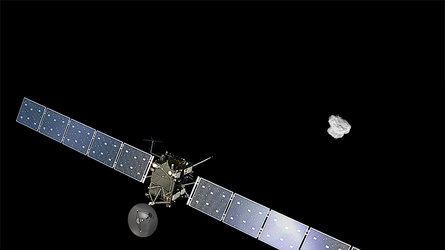ESOC swings into action for Rosetta swingby
Rosetta ground controllers generally lead a quiet life shepherding their 3-tonne spacecraft on its 10-year trip to rendezvous with a comet. But with a payload check-out this month and Mars and Earth swing-bys in 2007, activity at ESOC for several cooperating teams is becoming intense.
The two 2007 gravity assists are part of three Earth fly-bys and a Mars fly-by that will usher the spacecraft to a 2014 arrival at Comet 67P/Churyumov-Gerasimenko, where it will deploy a probe to make a spectacular comet landing.
ESA's Rosetta spacecraft and lander are on a usually quiet, 10-year journey to meet Comet 67P/Churyumov-Gerasimenko, scheduled for May 2014. Ground controllers at ESOC, ESA's Space Operations Centre in Darmstadt, Germany, typically only communicate with the spacecraft once per week to test communications.
But since September, the flight control team has been intensely focused on a series of manoeuvres designed to direct the spacecraft towards a vital Mars swingby, scheduled for 25 February 2007. The Mars gravity assist will be followed in turn by an Earth swingby (the second since launch) on 13 November 2007; one more Earth swing-by is scheduled for 2009. In addition, Rosetta instruments will be checked out and test-pointed this month in preparation for a planned 36-hour observation campaign targeting the asteroid Lutetia, scheduled for 2-4 January 2007.

"We knew Rosetta was not perfectly lined up, so we conducted thruster burns on 29 September and 13 November to be in position for February's Mars gravity assist. We're on track now and will make our closest approach to Mars on 25 February," said Andrea Accomazzo, Spacecraft Operations Manager (SOM) for Rosetta. Accomazzo joins the Rosetta team as of 1 December after serving as SOM for sister spacecraft Venus Express.
The burns, using Rosetta's manoeuvre thrusters, generated a change in velocity of 31.9 metres per second and 0.1 metres per second.
Mars swing-by slows craft for later Earth encounter
Rosetta is scheduled to make a very tight, 250-km swing-by of Mars on 25 February 2007, now estimated for 01:58 UTC. The Mars gravity assist is designed to slow the spacecraft down and position it for a subsequent Earth swingby eight months later.
"The overall change in velocity predicted from the Mars swing-by on 25 February is -2.19 km per second with respect to the Sun," says Trevor Morley, Flight Dynamics specialist for Rosetta at ESOC. "The Mars swingby is really a means to get the conditions right for the two future Earth swingbys to pump up the orbital energy," he says.
Flight dynamics plays vital role
For the two manoeuvres on 29 September and 13 November, we had great support from the flight dynamics team here at ESOC.
The complex series of planetary gravity assists needed for Rosetta underlines the vital role played by Flight Dynamics scientists working at ESOC.
These specialists are responsible for calculating spacecraft trajectories and attitudes, and they use sophisticated analytical tools to calculate such fundamental quantities as a spacecraft's speed, direction, location and orientation.
"Experts in the areas of orbits, optimisation, attitude monitoring, command generation and quality assurance cooperate as a single team to provide Rosetta flight dynamics support to the flight control team and the scientific community," says Morley.
Dynamics calculations rely on data from a number of sources, including range and Doppler information generated by the ground stations that receive radio signals from a spacecraft, as well as information from onboard star trackers and Sun sensors that can report a spacecraft's orientation with respect to (apparently) fixed distant stars and the Sun.
The task is made more complicated by the fact that sensitive instruments must be kept pointed away from the Sun, while solar panels must usually be kept facing the Sun. Furthermore, some spacecraft are spin stabilized, meaning they constantly rotate, so the star field seen by a star tracker also constantly rotates.

"For the two manoeuvres on 29 September and 13 November, we had great support from the flight dynamics team here at ESOC, who do all the detailed calculations on duration of burn, as well as the ground station support people," said Accomazzo. "For the instrument check-out on 27 November, we also worked closely with the Science Operations Centre at ESTEC," he added, referring to the SOC located at ESA's Technology and Research Centre in The Netherlands.
Communications with Rosetta are carried out via ESA's 35-metre deep-space antenna at the New Norcia ground station, in Australia, part of ESA's ESTRACK global network of stations.









